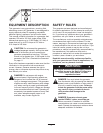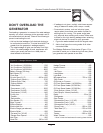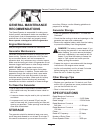
Generac Portable Products SE10000 Generator
3
The generator produces a very powerful voltage that
can cause serious injury or death by electrocution.
Never touch bare wires or receptacles. Never permit
a child or any unqualified person to operate the
generator.
Never handle any kind of electrical cord or device
while standing in water, while barefoot or while
hands or feet are wet.
Use a ground fault circuit interrupter (GFCI) in any
damp or highly conductive area (such as metal
decking or steel work).
Never use worn, bare, frayed or otherwise damaged
electrical cords with the generator.
Gasoline is highly FLAMMABLE and its vapors
are EXPLOSIVE. Never allow smoking, open
flames, sparks or heat in the vicinity while
handling gasoline. Avoid spilling gasoline on a hot
engine. Comply with all laws regulating storage and
handling of gasoline.
Do not overfill the fuel tank. Allow room for fuel
expansion. If tank is overfilled, fuel can overflow
onto a hot engine and cause a FIRE or an
EXPLOSION.
Never store a generator with fuel in the tank where
gasoline vapors might reach an open flame, spark
or pilot light (as on a furnace, water heater, clothes
dryer). FIRE or an EXPLOSION may result.
Do not insert any object through cooling slots of the
engine. You could damage the unit or injure
yourself.
The unit requires an adequate flow of cooling air for
its continued proper operation. Never operate the
unit inside any room or enclosure where the free
flow of cooling air into and out of the unit might be
obstructed. Allow at least 3 feet of clearance on
all sides of generator or you could damage the unit.
Never operate the generator:
in rain; in any enclosed compartment; if connected
electrical devices overheat; if electrical output is
lost; if engine or generator sparks; if flame or smoke
is observed while unit is running; if unit vibrates
excessively.
GROUNDING THE
GENERATOR
The National Electric Code requires the frame and
external electrically conductive parts of the generator
be properly connected to approved earth ground.
Local electrical codes may also require proper
grounding of the unit. For this purpose, a grounding
wing nut (Figure 1) is provided on the cradle.
Generally, connecting a No. 12 AWG (American Wire
Gauge) stranded copper wire to the grounding wing
nut and to an earth-driven copper or brass grounding
rod (electrode) provides adequate protection against
electrical shock. However, local codes may vary
widely. Consult with a local electrician for grounding
requirements in your area. Be sure to keep the ground
wire attached while you connect the electrode.
Properly grounding the generator helps prevent
electrical shock if ground fault conditions exists in the
generator or in connected electrical devices. Proper
grounding also helps dissipate static electricity, which
often builds up in ungrounded devices.
Figure 1 Location of Grounding Wing Nut
Grounding Wing Nut


















